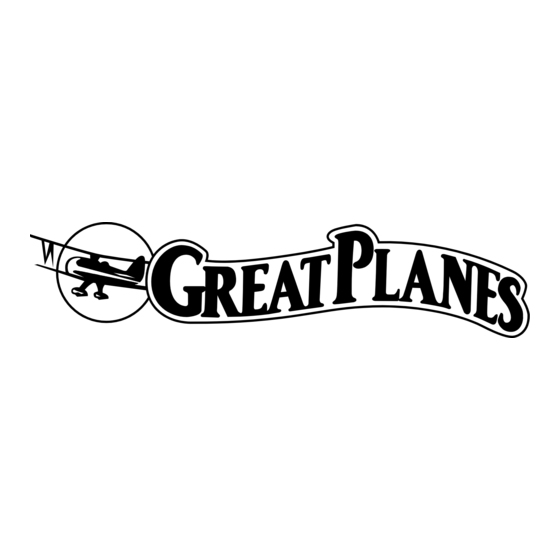GREAT PLANES SU-31 Manuel d'instruction - Page 15
Parcourez en ligne ou téléchargez le pdf Manuel d'instruction pour {nom_de_la_catégorie} GREAT PLANES SU-31. GREAT PLANES SU-31 16 pages. Park flyers series

The motor gets hot! Do not touch it during or right
after operation.
The electric motor and battery used in your Sukhoi SU-31
ARF are very powerful and the spinning propeller has a
lot of momentum; therefore, if you touch the propeller
while it is spinning it may inflict severe injury. Respect
the motor and propeller for the damage it is capable of
and take whatever precautions are necessary to avoid
injury. Always disconnect and remove the battery until
you are ready to fly again and always make sure the
switches are turned off before connecting the battery.
AMA SAFETY CODE (
Read and abide by the following Academy of Model
Aeronautics Official Safety Code:
1. I will not fly my model aircraft in sanctioned events, air
shows, or model flying demonstrations until it has been
proven to be airworthy by having been previously
successfully flight tested.
2. I will not fly my model aircraft higher than approximately
400 feet within 3 miles of an airport without notifying the
airport operator. I will give right of way to and avoid flying in
the proximity of full scale aircraft. Where necessary an
observer shall be used to supervise flying to avoid having
models fly in the proximity of full scale aircraft.
3. Where established, I will abide by the safety rules for the
flying site I use and I will not willfully and deliberately fly my
models in a careless, reckless and/or dangerous manner.
7. I will not fly my model unless it is identified with my
name and address or AMA number, on or in the model.
9. I will not operate models with pyrotechnics (any device
that explodes, burns, or propels a projectile of any kind).
Radio Control
1. I will have completed a successful radio equipment
ground check before the first flight of a new or repaired model.
2. I will not fly my model aircraft in the presence of
spectators until I become a qualified flier, unless assisted by
an experienced helper.
3. I will perform my initial turn after takeoff away from the
pit or spectator areas and I will not thereafter fly over pit or
spectator areas, unless beyond my control.
4. I will operate my model using only radio control frequencies
currently allowed by the Federal Communications Commission.
EXCERPT
General
During the last few moments of preparation your mind
may be elsewhere anticipating the excitement of the first
flight. Because of this, you may be more likely to overlook
certain checks and procedures that should be performed
before the model is flown. To help avoid this, a checklist is
provided to make sure these important areas are not
overlooked. Many are covered in the instruction manual,
so where appropriate, refer to the manual for complete
instructions. Be sure to check the items off as they are
completed (that's why it's called a check list !).
)
1. Check the C.G. according to the measurements
provided in the manual.
2. Be certain the battery and receiver are securely
mounted in the fuse.
3. Extend your receiver antenna and make sure it has a
strain relief to keep tension off the solder joint inside
the receiver.
4. Balance your model laterally as explained in
the instructions.
5. Use threadlocking compound to secure critical fasteners
such as the screw-lock pushrod connectors, etc.
6. Add a drop of oil to the axles so the wheels will turn freely.
7. Make sure all hinges are secure.
8. Reinforce holes for wood screws with thin CA where
appropriate (servo mounting screws).
9. Confirm that all controls operate in the correct direction
and the throws are set up according to the manual.
10. Make sure that all servo arms are secured to the
servos with the screws included with your radio.
11. Secure connections between servo wires and
Y-connectors or servo extensions with vinyl tape, heat
shrink tubing or special clips suitable for that purpose.
12. Make sure any servo extension cords you may have
used do not interfere with other systems (servo arms,
pushrods, etc.).
13. Balance your propeller (and spare propellers).
14. Tighten the propeller nut.
15. Place your name, address, AMA number and
telephone number on or inside your model.
16. Cycle your battery pack (if necessary) and make sure
it is fully charged.
17. If you wish to photograph your model, do so before
your first flight.
18. Range check your radio when you get to the flying field.
The Sukhoi SU-31 ARF is a great-flying model that flies
smoothly and predictably. The Sukhoi SU-31 ARF does not,
however, possess the self-recovery characteristics of a primary
R/C trainer and should be flown only by experienced R/C pilots.
If you are an inexperienced modeler we strongly urge you to
seek the assistance of a competent, experienced R/C pilot to
check your model for airworthiness AND to teach you how to fly.
15
